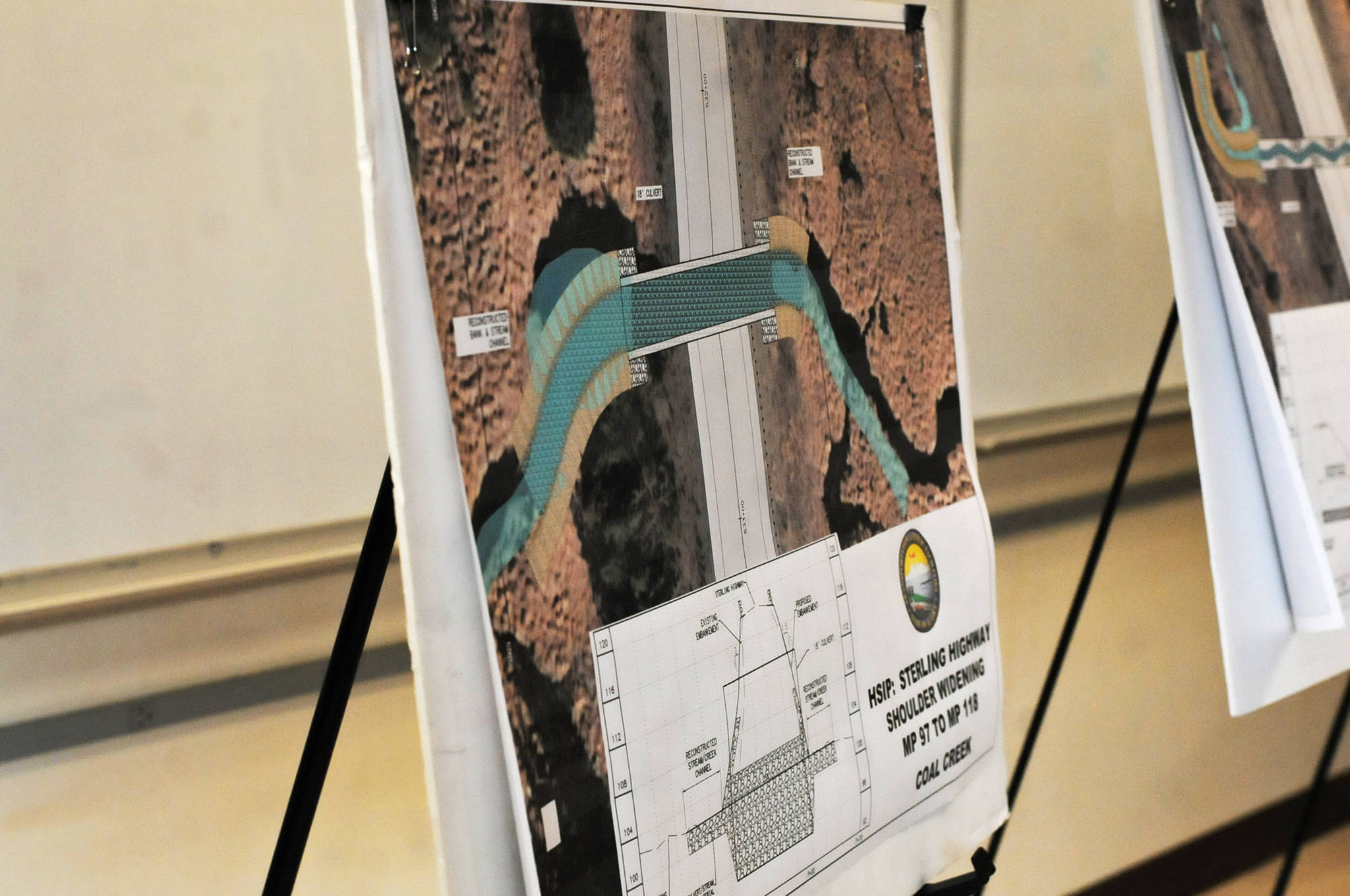The Alaska Department of Transportation and Public Facilities is working on a final set of plans to widen the shoulders of the Sterling Highway between Soldotna and Clam Gulch.
To improve safety along the two-lane stretch of highway, highly trafficked in the summer by both residents and tourists passing through on their way to Homer, DOT plans to widen the existing shoulders from 4 feet wide to 8 feet wide, add rumble strips and reflective lines, create a safety edge and replace culverts on streams that cross the highway, among other safety improvements. Kasilof residents got a look at the latest draft of plans for the project, known as the Sterling Highway Milepost 97–118 Project, at an open house at Tustumena Elementary School on Wednesday.
Other than the fish passage culverts, the project — estimated at between $30 million and $40 million — is being fully funded by the federal government as part of the Highway Safety Improvement Program, a federal program that offers funds to update roads identified as safety problems by the number of traffic accident deaths and serious injuries. The section of the Sterling Highway between Soldotna and Clam Gulch saw 266 accidents between 2006 and 2010, about 93 of which could have been prevented or made less severe by wider shoulders, rumble strips or a pavement safety edge, according to data provided by DOT.
The Wednesday meeting was part of a public engagement process that began last fall, seeking public comment on the project.
“The DOT&PF is sensitive to the needs of local residents and businesses and is committed to working with you to address your concerns on this project,” the project’s website states.
One of the project’s major pieces is improving fish passage through the culverts on the area’s streams. Four streams will be impacted — a Slikok Creek tributary, Coal Creek, an unnamed creek near Clam Gulch and Crooked Creek. All four will improve fish passage by widening the pipes and restoring some of the streambanks.
At Crooked Creek, two existing culverts will be replaced with one approximately 35-foot culvert, which will improve fish passage and safety. The two eight-foot culverts allow the water through, but the new passage will more than double the width.
It will also solve some of the scouring at the downstream outlet that has led to an outfall, called “perching,” in which the fish have to jump to make it into the culvert to move upstream.
Crooked Creek has naturally occurring run of king salmon and is stocked with hatchery kings each year by the Alaska Department of Fish and Game. Fish and Game maintains a weir on Crooked Creek for the naturally occurring king salmon run there, not counting the hatchery kings.
DOT decided to go with a large culvert instead of a bridge over the creek because it will be faster to install, said Greg Hartman, the consultant coordinator on the project for DOT. The culvert has to meet all the same safety standards as a bridge would, and the one proposed for Crooked Creek is a similar size to another one in Anchorage that runs beneath a four-lane highway, he said.
Altogether, the new culverts are going to improve the fish passage and stream function in the area, he said.
“It’s going to be quite a boon to the area,” he said.
In the data-gathering and analysis phase, the project team found out from the U.S. Fish and Wildlife Service that expanding and improving the culvert at Coal Creek would open up additional habitat for salmon as well, said Josh Cross, the design project manager for Lounsbury and Associates, the consulting firm designing the project. Fish will certainly benefit, and so will other wildlife that moves along the creek corridor, he said.
“Fish passage is sort of a misnomer in some ways,” he said. “… It just allows movement through a watershed.”
The community seemed fairly receptive to the project at the meeting in Kasilof, he said. The consultants and DOT staff members heard concerns about moose collisions, river protection and tree clearance, but in general, the tone was very positive, with people coming to learn, he said.
“It was one of the more positive public meetings I’ve been involved in,” he said. “A lot of the people that came out, they didn’t want to argue — they didn’t have a really specific issue with the project. Nobody really heard any negatives about it, and people seemed really interested in the fish passage culverts.”
DOT doesn’t dictate to the contractors what the method of executing the contract is, so Hartman said he didn’t know what the construction process would look like.
To secure federal funding, DOT aims to have finalized plans by July or August, with construction set up to begin in summer 2018, he said. The public can comment throughout the rest of the process, but the sooner comments come in the better, he said.
“Our ability to change anything major at the project is really diminished at that point (after plans are finalized and permits are obtained),” he said.
Reach Elizabeth Earl at elizabeth.earl@peninsulaclarion.com.

